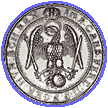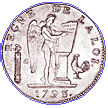| Symbols  ver ver
 2
millenia a specialized language of symbols has been developed for
use on coins and medals. These symbols communicate messages about
sovereignty—the nature of the issuing nation and of its rulers,
and how the they wished to be viewed. Symbols of sovereignty can
be divided into three major categories: 2
millenia a specialized language of symbols has been developed for
use on coins and medals. These symbols communicate messages about
sovereignty—the nature of the issuing nation and of its rulers,
and how the they wished to be viewed. Symbols of sovereignty can
be divided into three major categories:
 Symbols
representing corporate political entities (democracies, oligarchies,
federations, republics) Symbols
representing corporate political entities (democracies, oligarchies,
federations, republics)
 Symbols
representing political entities ruled by individuals (dictatorships,
minor principalities, monarchies, empires). Symbols
representing political entities ruled by individuals (dictatorships,
minor principalities, monarchies, empires).
 Symbols
with meanings transcending the political organization of the issuer,
including gods and various creatures, real and mythical. Symbols
with meanings transcending the political organization of the issuer,
including gods and various creatures, real and mythical.
Among the symbols of individual sovereignty are those listed below:
- Crowns are the symbols of
individual sovereignty par excellence. They are almost always
worn by rulers to indicate their rank and are often made of precious
metals and adorned with precious stones. In fact, the term crown
has come to be applied to the royal office itself.
- Coronets are smaller crowns worn by noble persons or the
five orders of peers: dukes, marquesses, earls, viscounts,
and barons.
- Fillets are headbands or ribbons tied around long hair to
keep it out of the eyes.
- Diadems were originally headbands made of cloth, and later became
metal headbands worn as symbols of power.
- Miters are tall caps having an archlike outline in
the front and the back, and are worn by high church
officials.
The
shape is supposed to represent the cloven tongues
of fire that descended
on the apostles on the day of Pentecost.
- Orbs are symbols of dominance and universal rule.
- Scepters are emblems of royal authority.
- Swords as symbols of power and strength.
- Tiaras are ornamental coronets worn by women or, in ecclesiastical
usage, the Pope. The term is also applied to high headdresses
or turbans worn by the ancient Persians and others.
- Turbans are Eastern cloth headdresses wound either
about a cap or directly about the head.
- Wreaths are circular bands of flowers, foliage, or
the like.
 Symbols of corporate sovereignty, often developed in opposition to monarchies
and associated with liberty or freedom, include a wide range
of objects, gods, and personifications of ideas. The the use
of gods associated with the issuing authority through identification
or by perceived attributes goes back to the ancient Greeks. The
Romans invented many of the symbols and personifications
still used today as symbols of corporate sovereignty. Among these
are: Symbols of corporate sovereignty, often developed in opposition to monarchies
and associated with liberty or freedom, include a wide range
of objects, gods, and personifications of ideas. The the use
of gods associated with the issuing authority through identification
or by perceived attributes goes back to the ancient Greeks. The
Romans invented many of the symbols and personifications
still used today as symbols of corporate sovereignty. Among these
are:
- Fasces, originally a symbol
of the Roman Republic, this symbol (an axe wrapped in a bundle
of rods) was resurrected during the French Revolution, and
later used in the U.S. Mercury dime. The symbol has fallen
from favor as a symbol of political freedom since its adoption
by Mussolini as a symbol of the Italian Fascist party.
- Liberty, personified as
a woman in many different forms—she represents a synthesis of
ancient personifications often used to represent cities or nations
on coins. (For example, Roma, or any number of representations
of cities throughout the Roman world and later, Britannia as the
personification of Great Britain.)
- Liberty cap, originally worn by freed slaves in the Roman world (the pileus libertatis),
the liberty cap was adopted as a symbol of political freedom,
first by the Dutch in 1681, and then during the revolutions
of the late 18th and early 19th centuries.
The third class of symbols is represented by the following:
- Eagles are among the most
popular of images to appear on coins, beginning in ancient Greece
and continuing into the present. They have represented many things
including divine patronage as the avatars of Zeus, imperial power,
national endurance, and majesty.
- Lions have been popular since the earliest
days of coinage as symbols of power and strength.
- Sun rays have represented the sun god, divinity,
and in the Christian world divine intervention and favor.
|

